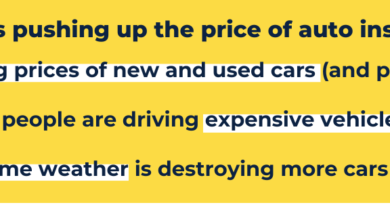Find the Right Auto Insurance Plan for You – ssunnel
Find the Right Auto Insurance Plan for You
Navigating the complex landscape of auto insurance is a crucial yet often daunting task for many individuals. As drivers seek to protect themselves and their vehicles from unforeseen events, understanding the various types of coverage available is paramount. This undertaking requires a careful evaluation of personal needs, financial situations, and potential risks, all while comparing options from a myriad of insurers. For instance, comprehensive auto insurance covers vehicle damage from non-collision incidents, which can be particularly advantageous for those in urban environments prone to vandalism or natural disasters, as illustrated in . Moreover, the rise of insurtech innovations is reshaping how consumers approach insurance by enhancing efficiency and providing personalized coverage solutions, reflecting a broader trend in the market . Ultimately, making informed choices about auto insurance plans can significantly influence ones financial security and peace of mind on the road.

A. Importance of choosing the right auto insurance plan
Selecting the appropriate auto insurance plan is crucial for ensuring financial security and peace of mind in the event of an accident. Different plans offer varying levels of coverage, including liability, comprehensive, and collision, each tailored to specific needs and circumstances. Comprehensive insurance, for example, provides protection from damages not caused by direct collisions, such as theft or natural disasters, thereby enhancing ones overall coverage strategy . Moreover, understanding the nuances between various policies helps consumers navigate a landscape often filled with technical jargon and complex terms, ensuring they make informed decisions that align with their financial situations and driving habits. This understanding is further underscored by emerging trends in the insurance industry, where technological innovation plays a transformative role, as noted by experts (Yogesh K Dwivedi et al., p. 102642-102642). Therefore, choosing the right auto insurance plan not only protects against unforeseen incidents but also serves as a proactive measure for responsible financial management (Mart Fínez‐Plumed et al., p. 3048-3061).
II. Understanding Auto Insurance Basics
Understanding auto insurance basics is essential for making informed decisions when selecting a plan that best suits individual needs. Auto insurance comprises various types, including liability, collision, and comprehensive coverage, each designed to protect drivers in different scenarios. For instance, comprehensive insurance, as depicted in , covers damages not caused by collisions, such as theft or natural disasters, thereby offering a broader safety net. Furthermore, financial literacy surrounding auto insurance policies, such as recognizing coverage limits and deductibles, is critical yet often overlooked, particularly among young adults who may lack formal education in personal finance, as highlighted by (Braley et al.). In a dynamic insurance landscape influenced by technology, understanding innovations in insurtech can also guide consumers toward more efficient policy choices, aligning with suggestions from (Gantwerk H et al.). Grasping these fundamentals enables individuals to navigate the complexities of auto insurance effectively and choose optimal coverage.
A. Key terms and coverage types in auto insurance
Understanding the key terms and coverage types in auto insurance is essential for selecting an appropriate policy. Fundamental coverage types include liability, collision, and comprehensive insurance. Liability insurance covers damages to others if the insured is at fault in an accident, while collision insurance compensates for vehicle repairs following a collision, regardless of fault. Comprehensive insurance, described in , protects against non-collision damages, such as theft or natural disasters, providing a holistic safety net for vehicle owners. Additionally, recognizing terms like deductibles, premiums, and limits is crucial when analyzing policy options to ensure adequate financial protection. As financial stability is often intertwined with life changes, effective policy recommendations should address coverage needs during transitions, echoing the perspectives noted in (Ann O’Leary et al.). Thus, a comprehensive understanding of these terms and coverage types aids consumers in making informed decisions for their specific situations.
III. Factors to Consider When Choosing an Auto Insurance Plan
When choosing an auto insurance plan, several crucial factors come into play to ensure that the selected policy effectively meets one’s needs. A primary consideration should be the types of coverage offered, which can range from liability to comprehensive policies. Understanding the specifics of deductibles and premium costs is essential, as these elements directly influence overall affordability and financial protection during unforeseen events. Additionally, potential discounts and coverage limits can significantly affect long-term savings, making the analysis of policy options critical for informed decision-making (Ann O’Leary et al.). Furthermore, individuals should evaluate their personal financial situation, including current savings and debts, to determine the best insurance plan compatible with their economic landscape (Department CA). Ultimately, a comprehensive understanding of these factors will empower consumers to select an auto insurance plan that balances adequate coverage with financial prudence.
A. Assessing personal needs and budget for auto insurance
Evaluating personal needs and budget for auto insurance is a crucial step in selecting the right plan, as it directly influences coverage efficiency and financial management. Individuals must first assess their specific requirements, including vehicle type, driving habits, and potential risks, to determine the necessary coverage levels. Alongside this, understanding ones financial constraints is vital; premium costs must fit within a monthly budget while also considering deductibles and out-of-pocket expenses in the event of a claim. Incorporating comprehensive coverage can provide additional protection against non-collision incidents, illustrated by , which underscores the significance of safeguarding ones investment in the vehicle. As the market continues evolving, informed consumers must adapt their approaches, reflecting the transition from principles to actionable insights in auto insurance, resonating with the goals outlined by the OECD to optimize benefits without leaving anyone behind (N/A).
selecting the right auto insurance plan involves careful consideration of various factors that align with individual needs and circumstances. As demonstrated throughout this essay, understanding the nuances of different coverage types—such as liability, collision, and comprehensive—can empower consumers to make informed decisions. The integration of technology in the insurance sector, highlighted by insurtech innovations, has further streamlined the process of comparing plans and rates. It is crucial for policyholders to remain proactive, as changes in life circumstances can significantly impact insurance requirements, especially during transitions like unemployment or divorce (Ann O’Leary et al.). Moreover, the principles of managed competition can lead to improved quality and reduced costs in coverage options (Alain C Enthoven). By prioritizing these considerations, individuals can not only protect their assets but also ensure a tailored approach that reflects their unique lifestyles, ultimately enhancing their financial security. To complement this discussion, offers a visual representation of the comprehensive coverage necessary for safeguarding against non-collision-related damages, further emphasizing the importance of thorough evaluation in the auto insurance selection process.
A. Recap of the importance of informed decision-making in selecting auto insurance
In selecting the right auto insurance, informed decision-making is crucial for ensuring adequate coverage that meets individual needs and financial circumstances. Many consumers overlook the significance of evaluating various policies, often leading to insufficient protection against potential liabilities. For instance, understanding the nuances of comprehensive insurance, which covers damages not resulting from collisions, can significantly impact an individuals financial stability in the event of unexpected incidents . Additionally, as the insurance landscape rapidly evolves with technological advancements, it is essential for consumers to remain vigilant about new offerings and innovations within the sector (Yogesh K Dwivedi et al., p. 102642-102642). By engaging in thorough research and critical analysis of different insurance plans, individuals empower themselves to safeguard their assets effectively while navigating a complex market (N/A). This proactive approach not only ensures suitable coverage but also fosters a greater understanding of ones rights and responsibilities within the realm of auto insurance.



